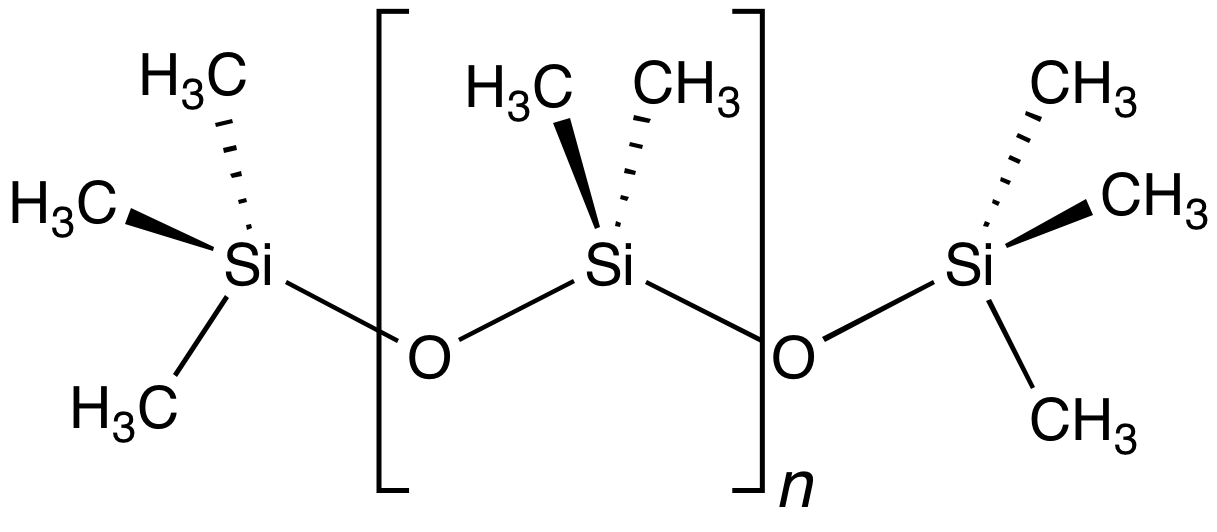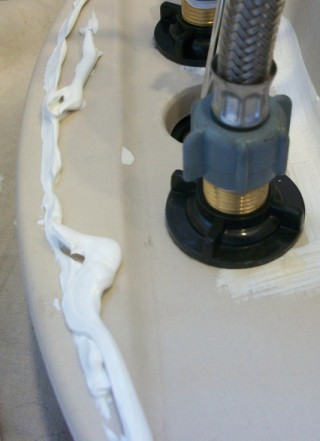|
Organosilicon
Organosilicon chemistry is the study of organometallic compounds containing carbon–silicon bonds, to which they are called organosilicon compounds. Most organosilicon compounds are similar to the ordinary organic compounds, being colourless, flammable, hydrophobic, and stable to air. Silicon carbide is an ''inorganic'' compound. History In 1863, Charles Friedel and James Crafts made the first organochlorosilane compound. The same year, they also described a "polysilicic acid ether" in the preparation of ethyl- and methyl-o-silicic acid. Extensive research in the field of organosilicon compounds was pioneered in the beginning of 20th century by Frederic S. Kipping. He also had coined the term "silicone" (resembling ''ketones'', though this is erroneous) in relation to these materials in 1904. In recognition of Kipping's achievements, the Dow Chemical Company had established an award in the 1960s that is given for significant contributions to the field of silicon chemistry ... [...More Info...] [...Related Items...] OR: [Wikipedia] [Google] [Baidu] |
Silicone
In Organosilicon chemistry, organosilicon and polymer chemistry, a silicone or polysiloxane is a polymer composed of repeating units of siloxane (, where R = Organyl group, organic group). They are typically colorless oils or elastomer, rubber-like substances. Silicones are used in sealants, adhesives, lubricants, medicine, cooking utensils, thermal insulation, and electrical insulation. Some common forms include silicone oil, silicone grease, grease, silicone rubber, rubber, silicone resin, resin, and Caulking, caulk. Silicone is often confused with one of its constituent elements, silicon, but they are distinct substances. Silicon is a chemical element, a hard dark-grey semiconductor, semiconducting metalloid, which in its crystalline form is used to make integrated circuits ("electronic chips") and solar cells. Silicones are compounds that contain silicon, carbon, hydrogen, oxygen, and perhaps other kinds of atoms as well, and have many very different physical and chemical ... [...More Info...] [...Related Items...] OR: [Wikipedia] [Google] [Baidu] |
Organometallic Compound
Organometallic chemistry is the study of organometallic compounds, chemical compounds containing at least one chemical bond between a carbon atom of an organic molecule and a metal, including alkali, alkaline earth, and transition metals, and sometimes broadened to include metalloids like boron, silicon, and selenium, as well. Aside from bonds to organyl fragments or molecules, bonds to 'inorganic' carbon, like carbon monoxide ( metal carbonyls), cyanide, or carbide, are generally considered to be organometallic as well. Some related compounds such as transition metal hydrides and metal phosphine complexes are often included in discussions of organometallic compounds, though strictly speaking, they are not necessarily organometallic. The related but distinct term " metalorganic compound" refers to metal-containing compounds lacking direct metal-carbon bonds but which contain organic ligands. Metal β-diketonates, alkoxides, dialkylamides, and metal phosphine complexes are r ... [...More Info...] [...Related Items...] OR: [Wikipedia] [Google] [Baidu] |
Frederic Kipping
(Frederic) Stanley Kipping FRS (16 August 1863 – 1 May 1949) was an English chemist. He undertook much of the pioneering work on silicon polymers and coined the term silicone. Life He was born in Salford, Lancashire, England, the son of James Kipping, a Bank of England official, and Julia Du Val, a daughter of painter Charles Allen Du Val. He was educated at Manchester Grammar School before enrolling in 1879 at Owens College (now Manchester University) for an external degree from the University of London. After working for the local gas company for a short time he went in 1886 to Germany to work under William Henry Perkin, Jr. in the laboratories of Adolf von Baeyer at Munich University. Back in England, he took a position as demonstrator for Perkin, who had been appointed professor at Heriot-Watt College, Edinburgh. In 1890, Kipping was appointed chief demonstrator in chemistry for the City and Guilds of London Institute, where he worked for the chemist Henry Edward Arms ... [...More Info...] [...Related Items...] OR: [Wikipedia] [Google] [Baidu] |
Silafluofen
Silafluofen is a fluorinated organosilicon pyrethroid insecticide. Silafluofen is used agriculturally against soil-borne insects such as termites, and as a wood preservative. It is registered in Asia (India, Japan, Taiwan, Vietnam) since at least 1995 for crops such as drupes In botany, a drupe (or stone fruit) is a type of fruit in which an outer fleshy part ( exocarp, or skin, and mesocarp, or flesh) surrounds a single shell (the ''pip'' (UK), ''pit'' (US), ''stone'', or '' pyrena'') of hardened endocarp with a s ..., tea and rice, but has not been notified or authorised in the European Union for example. References Pyrethroids Organofluorides Organosilicon compounds Diphenyl ethers Ethoxy compounds {{Ether-stub ... [...More Info...] [...Related Items...] OR: [Wikipedia] [Google] [Baidu] |
Charles Friedel
Charles Friedel (; 12 March 1832 – 20 April 1899) was a French chemist and Mineralogy, mineralogist. Life A native of Strasbourg, France, he was a student of Louis Pasteur at the University of Paris, Sorbonne. In 1876, he became a professor of chemistry and mineralogy at the Sorbonne. Friedel developed the Friedel–Crafts reaction, Friedel-Crafts alkylation and acylation reactions with James Crafts in 1877, and attempted to make synthetic diamonds. Friedel's wife's father was the engineer, Charles Combes. , quercy.net, accessed April 2010 The Friedel family is a rich lineage of French scientists: * Georges Friedel (1865–1933), French crystallographer and mineralogist; son of Charles * Edmond Friedel (1895–1972), French Polytechnician and mining engineer, founder of :fr:BRGM, BRGM, the French geological survey; son of Georges * Ja ... [...More Info...] [...Related Items...] OR: [Wikipedia] [Google] [Baidu] |
Müller-Rochow Process
The direct process, also called the direct synthesis, Rochow process, and Müller-Rochow process is the most common technology for preparing organosilicon compounds on an industrial scale. It was first reported independently by Eugene G. Rochow and Richard Müller in the 1940s.. The process involves copper-catalyzed reactions of alkyl halides with elemental silicon, which take place in a fluidized bed reactor. Although theoretically possible with any alkyl halide, the best results in terms of selectivity and yield occur with chloromethane (CH3Cl). Typical conditions are 300°C and 2–5bar. These conditions allow for 90–98% conversion for silicon and 30–90% for chloromethane. Approximately 1.4 Mton of dimethyldichlorosilane (Me2SiCl2) is produced annually using this process.Elschenbroich, Christoph Organometallics VCH, Weinheim, Germany: 1992. . Few companies actually carry out the Rochow process, because of the complex technology and high capital requirements. Since the silic ... [...More Info...] [...Related Items...] OR: [Wikipedia] [Google] [Baidu] |
Caulking
Caulk (also known as caulking and calking) is a material used to seal joints or seams against leakage in various structures and piping. The oldest form of caulk consisted of fibrous materials driven into the wedge-shaped seams between boards on wooden boats or ships. Cast iron sewerage pipes were formerly caulked in a similar way. Riveted seams in ships and boilers were formerly sealed by hammering the metal. Modern caulking compounds are flexible sealing compounds used to close up gaps in buildings and other structures against water, air, dust, insects, or as a component in firestopping. In the tunneling industry, caulking is the sealing of joints in segmental precast concrete tunnels, commonly by using concrete. Historical uses Wooden shipbuilding Traditional caulking (also spelled calking) on wooden vessels uses fibers of cotton and oakum (hemp) soaked in pine tar. These fibers are driven into the wedge-shaped seam between planks, with a caulking mallet and a broad ch ... [...More Info...] [...Related Items...] OR: [Wikipedia] [Google] [Baidu] |
Caulk
Caulk (also known as caulking and calking) is a material used to Seal (mechanical), seal Joint (building), joints or seams against leakage in various structures and piping. The oldest form of caulk consisted of fibrous materials driven into the wedge-shaped seams between boards on Boat building#Wood, wooden boats or ships. Cast iron Sanitary sewer, sewerage Water pipe, pipes were formerly caulked in a similar way. Riveted seams in ships and boilers were formerly sealed by hammering the metal. Modern caulking compounds are flexible sealing compounds used to close up gaps in buildings and other structures against water, air, dust, insects, or as a component in firestopping. In the tunneling industry, caulking is the sealing of joints in segmental precast concrete tunnels, commonly by using concrete. Historical uses Wooden shipbuilding Traditional caulking (also spelled calking) on wooden vessels uses fibers of cotton and oakum (hemp) soaked in pine tar. These fibers are drive ... [...More Info...] [...Related Items...] OR: [Wikipedia] [Google] [Baidu] |
Adjuvant
In pharmacology, an adjuvant is a drug or other substance, or a combination of substances, that is used to increase the efficacy or potency of certain drugs. Specifically, the term can refer to: * Adjuvant therapy in cancer management * Analgesic adjuvant in pain management * Immunologic adjuvant In immunology, an adjuvant is a substance that increases or modulates the immune response to a vaccine. The word "adjuvant" comes from the Latin word , meaning to help or aid. "An immunologic adjuvant is defined as any substance that acts to acce ... in vaccines {{sia Adjuvants ... [...More Info...] [...Related Items...] OR: [Wikipedia] [Google] [Baidu] |
Herbicide
Herbicides (, ), also commonly known as weed killers, are substances used to control undesired plants, also known as weeds.EPA. February 201Pesticides Industry. Sales and Usage 2006 and 2007: Market Estimates. Summary in press releasMain page for EPA reports on pesticide use ihere Selective herbicides control specific weed species while leaving the desired crop relatively unharmed, while non-selective herbicides (sometimes called "total weed killers") kill plants indiscriminately. The combined effects of herbicides, nitrogen fertilizer, and improved cultivars has increased yields (per acre) of major crops by three to six times from 1900 to 2000. In the United States in 2012, about 91% of all herbicide usage, was determined by weight applied, in agriculture. In 2012, world pesticide expenditures totaled nearly US$24.7 billion; herbicides were about 44% of those sales and constituted the biggest portion, followed by insecticides, fungicides, and fumigants. Herbicide is also used ... [...More Info...] [...Related Items...] OR: [Wikipedia] [Google] [Baidu] |
Fungicide
Fungicides are pesticides used to kill parasitic fungi or their spores. Fungi can cause serious damage in agriculture, resulting in losses of yield and quality. Fungicides are used both in agriculture and to fight fungal infections in animals, including humans. Fungicides are also used to control oomycetes, which are not taxonomically/genetically fungi, although sharing similar methods of infecting plants. Fungicides can either be contact, translaminar or systemic. Contact fungicides are not taken up into the plant tissue and protect only the plant where the spray is deposited. Translaminar fungicides redistribute the fungicide from the upper, sprayed leaf surface to the lower, unsprayed surface. Systemic fungicides are taken up and redistributed through the xylem vessels. Few fungicides move to all parts of a plant. Some are locally systemic, and some move upward. Most fungicides that can be bought retail are sold in liquid form, the active ingredient being present at 0.08% i ... [...More Info...] [...Related Items...] OR: [Wikipedia] [Google] [Baidu] |



